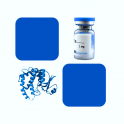
- Remove this product from my favorite's list.
- Add this product to my list of favorites.
Products
Newsletter
 |  |  |  |  |  |

Background
Granulocyte Colony Stimulating Factor Receptor (G-CSFR), also known as Cluster of Differentiation 114 (CD114), CSF3R and GCSF, is a cell-surface receptor for the granulocyte colony-stimulating factor (G-CSF), a cytokine that plays a critical role in the regulation of the activation, proliferation, differentiation, and survival of the neutrophilic granulocyte lineage. G-CSFR belongs to a family of cytokine receptors known as the hematopoietin receptor family. This type I membrane protein has a composite structure consisting of an immunoglobulin(Ig)-like domain, a cytokine receptor-homologous (CRH) domain and three fibronectin type I II (FNIII) domains in the extracellular region. G-CSFR is present mainly on precursor cells in the bone marrow, and, in response to stimulation by G-CSF, initiates cell proliferation and differentiation into mature neutrophilic granulocytes and macrophages. G-CSFR mediates the specific effect of GCSF through activating a variety of intracellular signaling cascades, including the Jak/Stat, PI3/Akt, Ras-Raf-MAP kinase, and Src family kinase pathways, and thus functions in defense against infection, inflammation and repair, and in the maintenance of steady state hematopoiesis. Mutations in this gene are a cause of Kostmann syndrome, also known as severe congenital neutropenia. Mutations in the intracellular part of this receptor are also associated with certain types of leukemia.
Source
Recombinant Human GCSFR /CD114 Protein, Fc Tag (GCR-H5250) is expressed from human 293 cells (HEK293). It contains AA Glu 25 - Pro 621 (Accession # NP_000751.1).
Predicted N-terminus: Glu 25
Molecular Characterization
This protein carries a human IgG1 Fc tag at the C-terminus.
The protein has a calculated MW of 92.7 kDa. The protein migrates as 100-120 kDa under reducing (R) condition (SDS-PAGE) due to glycosylation.
Endotoxin
Less than 1.0 EU per μg by the LAL method.
Purity
>95% as determined by SDS-PAGE.
Formulation
Lyophilized from 0.22 μm filtered solution in Tris with Glycine, Arginine and NaCl, pH7.5 with trehalose as protectant.
Reconstitution
See Certificate of Analysis for details of reconstitution instruction and specific concentration.
Storage
For long term storage, the product should be stored at lyophilized state at -20°C or lower.
Please avoid repeated freeze-thaw cycles.
This product is stable after storage at:
-20°C to -70°C for 12 months in lyophilized state;
-70°C for 3 months under sterile conditions after reconstitution.
Bioactivity
Please refer to product data sheet.
(1) "Incidence and risk factors for febrile neutropenia of patients with diffuse large B-cell lymphoma receiving R-CHOP-21 in China
Zheng, Chen, Zhu et al
Support Care Cancer (2023) 32 (1), 43
(2) "Mosunetuzumab Safety Profile in Patients With Relapsed/Refractory B-cell Non-Hodgkin Lymphoma: Clinical Management Experience From a Pivotal Phase I/II Trial
Matasar, Bartlett, Shadman et al
Clin Lymphoma Myeloma Leuk (2023)
(3) "Dose-dense neoadjuvant chemotherapy in triple-negative breast cancer: Real-world data from a developing country
Sharma, Gogia, Deo et al
Indian J Cancer (2024)
Showing 1-3 of 2256 papers.
Follow us